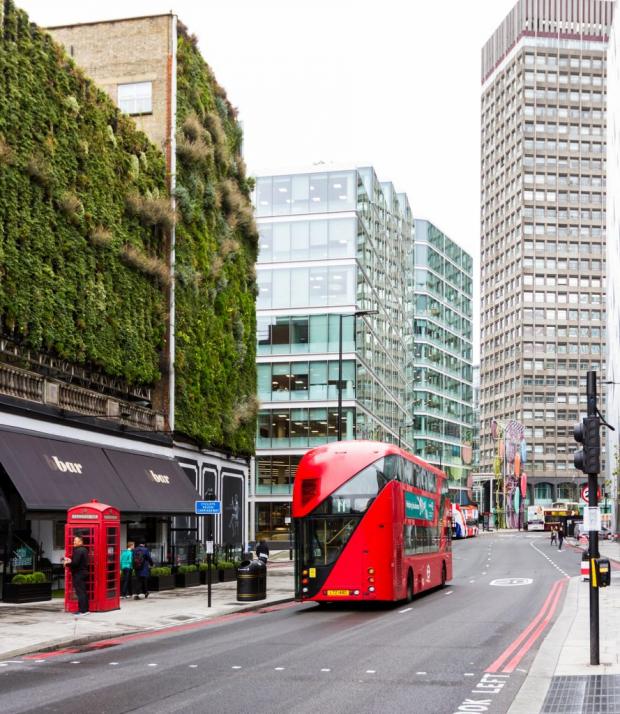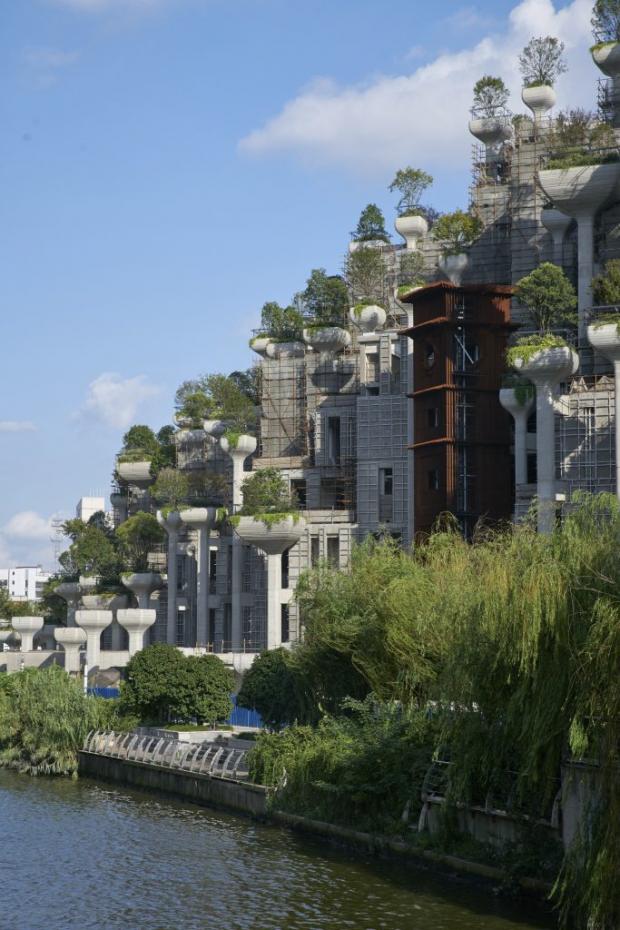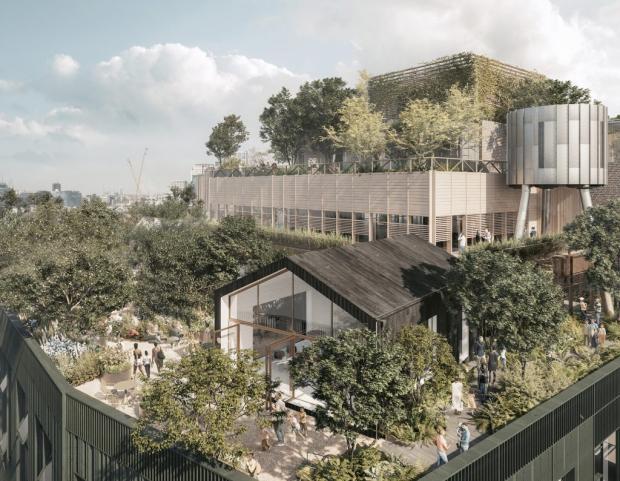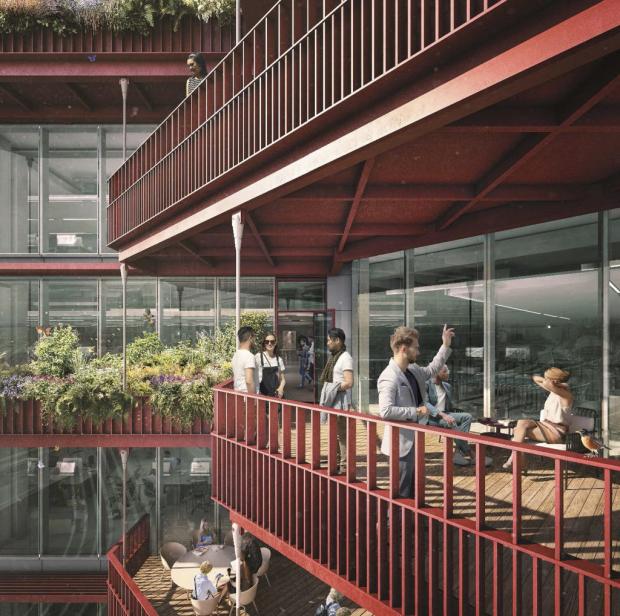Vegetation is returning to our cities. The trend started with rooftop planters on City banks in the 2000s, before spreading to the occasional green wall on a luxury hotel. Now, entire urban blocks are being transformed with ever-more ambitious plant projects.

Heatherwick Studio and BIG’s new headquarters for Google at King’s Cross promises a grass-laden ‘plateau’, two ‘tree walkways’, a ‘garden’ and even a ‘headland’ on its roof. Eric Parry’s latest City of London skyscraper will have a 26-storey green wall while KPF’s 70 Gracechurch Street will have planted terraces on more than 25 storeys.
Not to be outdone, an extension to Blackfriars Crown Court by Studio RHE will be topped with a 100-tree ‘forest’. In Salford, construction has started on an 11-storey office building by Make, which will feature a green wall façade around glazing. And another KPF office building in London’s Victoria will boast 2,800m2 of green space, including a rooftop ‘urban farm’ with ‘community allotments’.
This recent crop of verdant buildings is partly being driven by the demand for blingy – and greener– offices. Even before coronavirus, big companies were looking for offices that offered more than desk space, as well as a base from which to woo clients.
But there is more to the story than office wellness. Plants have a powerful ability to lower temperatures in cities, as well as make buildings more habitable through noise reduction, air filtration and creating attractive places. They are also crucial for improving the UK’s biodiversity.
In June, a report by the Climate Change Committee called for the government to urgently tackle heat-related deaths in homes by specifically encouraging measures such as better shading and green cover in cities.
And a report published by the RSPB and WWF this month said green walls and green roofs should be more widely adopted due to the ‘vital role’ they play in flood reduction, heating and cooling buildings, improving biodiversity and filtering air pollution.

Green wall on the B Bar in Westminster
Source:Nature’s Charm / Shutterstock.com
There is now an array of planning policies and environmental agendas pushing for green elements to be included in most new-build projects.
ADVERTISEMENT
But as green add-ons become a ‘must-have’, these big-money commercial projects are coming under increasing scrutiny. Critics argue rooftop gardens can’t neutralise the huge carbon emissions of building a new concrete and steel tower. So are claims around sustainability just marketing greenwash? Or are tree-lined luxury terraces and green walls on skyscrapers genuinely helping the planet?
In the UK, the trend towards greening buildings started with green roofs in the 2000s – notably in the City of London. There is now more than 5.8m2 of green roof per inhabitant in the Square Mile. Green walls came later, during the early 2010s, initially as luxury showpieces for hotels, shopping centres and high-end offices.
The impetus spread from continental Europe, where countries such as Germany had already begun exploring contemporary roof gardens and green walls – the latter invented in its modern-day form by Parisian botanist Patrick Blanc in the late 1990s. Despite starting as luxury items, they have rapidly become integrated into other buildings to improve spaces.
‘It takes 17 trees 10 years to absorb 1 tonne of CO2 while big commercial buildings cost tens of thousands of CO2 emissions – the beneficial carbon impact is insignificant’
This has been spurred on in the capital by the mayor of London’s provisions for greening in the London Plan – and the creation, in 2019, of the Urban Greening Factor by the Greater London Authority (GLA) to measure the quantity and quality of greening on a development proposal during the planning process.
Climate experts say plants are key to combatting the effects of climate change and making cities more livable. The UK Green Building Council has called for all new buildings and infrastructure to have ‘nature-based solutions’ by 2030 – to ensure they remain hospitable as cities heat up over the coming decades.
This is because plants absorb heat and cool down their surrounding air. Studies show that green walls can be up to 32°C cooler than conventional walls, and reduce air temperature around them by up to 4°C.
Urban greening is also key to boosting biodiversity, which is important for fighting climate change, making ecosystems resilient to change, and helping protect the 15 per cent of UK species that are threatened with extinction.
A recent example of this was the discovery of a small-flowered tongue orchid – previously believed to be extinct in the UK – on the roof garden of investment bank Nomura, in the City of London. The manager of the garden, who found the plant earlier this year, believes orchid seeds could have reached the bank after flying on the wind from mainland Europe.
Plants also absorb carbon from the atmosphere – a tree absorbs around 5.5kg of carbon dioxide a year, while 1m2 of green wall can absorb up to 2kg a year. And they remove harmful toxins from the air, such as nitrogen dioxide, helping to tackle the UK’s air pollution, responsible for around 32,000 deaths every year, according to Public Health England.
Greenery also makes cities nicer to live in. People have an innate connection to nature and are happier when they are around it. Heatherwick Studio founder Thomas Heatherwick says he designs greenery on buildings to ‘create a more human experience’.
Heatherwick, whose practice is working on the near-complete 1000 Trees project in China, featuring hundreds of structural planter-like columns, says: ‘It’s too easy to misinterpret the integration of plants into buildings as only being about trying to solve the climate crisis. The large quantity of plants on our studio’s 1000 Trees project in Shanghai certainly do sequester significant amounts of carbon from the atmosphere.

1000 Trees project in Shanghai, China by Heatherwick Studio
Source:Noah Sheldon
‘However, our starting point was to prioritise the public experience of living in a harsh existing context of soulless buildings.’
He adds: ‘As well as breaking up the monotony of endless monolithic buildings, many studies, such as Rachel and Stephen Kaplan’s Attention Restoration Theory, help us understand the extent to which nature can improve our mental health and ability to focus and concentrate.
‘When developers embrace the power of bringing nature into their projects, there is a generosity that should be recognised as a valuable contribution to long-lasting public enrichment.’
There are broadly two types of greenery used on today’s buildings: horizontal planting includes roof gardens and planted terraces, which can feature anything from grass to trees; and green walls, which incorporate shrubs, flowers and grasses planted vertically in soil or a hydroponic system.
Maintenance-heavy green walls tend to be less sustainable than roof gardens or other landscaping. ‘Rooftop forests have a greater positive impact on air quality and carbon capture than living walls, due to their size, scale, far greater longevity and impact,’ argues Clive Nichol, chief executive of developer Fabrix, which is redeveloping the former Blackfriars Crown Court with Studio RHE and Harris Bugg Studio.

Fabrix’s Roots in the Sky building with Studio RHE and Harris Bugg
Source:Fabrix
The building, including a new rooftop extension, will be topped with 100 trees and a total of 10,000 plants in more than 1,000 tonnes of soil.
‘It takes a lot of resources – water, materials and energy – to keep living walls in good condition, which is far less sustainable than a natural ecosystem,’ he says. ‘Too often, living walls are used as dressings rather than being at the very core of a project.’
But advocates of green walls argue that all the different types of green infrastructure are needed.
Typically, most plants prefer growing from the ground; an effective irrigation system and careful maintenance is needed to keep most green walls alive. Plants can thrive much more easily in a flat bed of soil.
However, the green walls occupy vertical areas – of which there are an abundance in cities – rather than valuable horizontal space. They are therefore a way of maximising greenery on a site and can be used instead of losing density by landscaping around a building.
Peter Massini, director at Future Nature Consulting and former head of green infrastructure at the GLA – where he spearheaded the creation of the Urban Greening Factor – admits that ‘green walls are a poor cousin to green roofs’.
Yet he acknowledges their value – especially the more recent attempts.
‘[Though] the early ones all failed,’ he says, ‘in the last five years, companies have developed systems which are pretty robust and resilient – and they also offer good maintenance contracts. The risk of failure is pretty small now, so green walls have certainly got a role to play.’
The environmental footprint of green walls varies depending on freshwater use, operational carbon use for irrigation and maintenance, and the embodied carbon of plants, parts and – if used – fertiliser.

Morris+Company’s designs for hanging gardens in Paddington Central
Source:Secchi Smith
Ambitious green walls stretching over several floors, such as those planned on some forthcoming skyscrapers, are likely to use a considerable supply of fresh water – as there will not be enough water harvested on the site to look after all the plants. They will also use more operational energy than most green walls to transport water up and down storeys.
Green walls also vary in biodiversity quality. An article in Landscape, the journal of the Landscape Institute, studied an abandoned green wall that had a greater biodiversity than most carefully maintained green walls – as nature took its course and insects and birds moved in.
‘We have to design more living walls with a different understanding of nature as slightly scruffy,’ says Tim Waterman, associate professor at the Bartlett School of Architecture. ‘But this is very much at odds with people’s vision of good urbanism as tidy.’
Alistair Law, an associate façade designer at Arup, agrees. Law has created a green wall system based on seeds. The system requires less maintenance than other green walls and attempts to create an English meadow ecosystem.
‘Architects struggle with a lack of control,’ he says. ‘They like their designs to be manicured and perfect. At the moment they are too keen to stick up plants which barely change over the course of a year – because they are selling renders.
‘A more natural green wall might not look great all the time, but even walls that die back for winter serve a purpose – such as providing a habitat for spiders, which in turn provide something for birds to eat – even if they do not look green.’
Green wall manufacturers say they are focused on reducing embodied carbon by using recycled and recyclable materials, producing systems with a longer lifespan, and reusing rainwater where possible. They point out that green walls also save operational carbon from buildings by improving the thermal efficiency of buildings.
‘Depending on the plant choice, approximately one year after installation we offset the carbon generated in the building of the living wall,’ says Angus Cunningham, chief executive of green wall manufacturer Scotscape.
Manufacturers also say they are improving the biodiversity of their products by including native plant species and plants that provide nectar or, where clients are amenable, adding in habitat boxes and bug hotels.
But despite the environmental benefits of having plants on buildings, rooftop gardens cannot neutralise vast quantities of operational or embodied carbon. ‘The green stuff is quite a clever commercial face-saver, but it’s not a game-changer,’ says Simon Sturgis, director of Targeting Zero. ‘The beneficial carbon emissions impact [from plants] is insignificant.
‘It takes roughly 17 mature trees 10 years to absorb one tonne of CO2. Big new commercial buildings will cost tens of thousands of CO2 emissions to build, let alone use, so you can see that the amount of greening shown [on some recent proposals] will make barely any impact.
‘My view is that provided the carbon cost of installing the greening does not outweigh the carbon benefit provided, then it is about health and wellbeing. My concern is that the provision of greening is about image and not content.’
When green roofs and green walls came to London, they were created where it suited developers. Banks in the Square Mile created rooftop gardens because they could afford to – and it suited them to have nice spaces for their employees. Similarly, some high-end housing and hotels were given greenery as it increased their financial value.
Although greening has been recognised as a benefit by planners for several years, the GLA is now trying to enforce much stricter demands around it, to reflect the fact that many of the benefits of greening – such as urban cooling and biodiversity increases – are a social gain.
Last month the GLA released a consultation document on the Urban Greening Factor after including provisions for it in its 2021 London Plan. The Urban Greening Factor assigns scores for 16 different types of surfaces ranging from 0 (sealed surfaces) to 1 (semi-natural vegetation or wetland). Other listed surfaces include green walls (0.6), amenity grassland (0.4) and permeable paving (0.1).
Under the London Plan, boroughs can create their own standards for urban greening, but a benchmark set by the GLA demands all commercial developments have an average score of 0.3 across their site, with residential developments scoring an average of 0.4.
Other cities are also catching on. All of the UK’s 10 largest cities welcome green roofs in their local development plans and several – such as Nottingham, Birmingham and Liverpool – say green infrastructure, including green walls, should be incorporated into new developments.
Further planning incentives for adding plants to buildings are set to set to be introduced by the government. The Environment Bill, which has almost worked its way through Parliament, contains a provision to require all planning applications to increase the biodiversity of the site in question by 10 per cent. The National Model Design Code, which sets out how local designs codes should be created throughout the country, also recognises green roofs as a valuable way in which nature can be woven into developments.
Benzion Kotzen, head of the University of Greenwich’s Green Roofs and Living Walls Centre, believes there will be more incentives for urban greening in the future. He points out that petrol and diesel cars already have to pay a congestion charge in London while electric cars don’t, and that building owners have to pay for their waste water to be dealt with but not yet for water coming off roofs – even though this can cause flooding.
‘We are heading for a future where if you are part of an environmental problem – for instance contributing to urban heat island effect or run-off water which causes flooding – you are going to have to pay a price,’ he says. ‘That will incentivise developers to spend money on mitigation instead.’
Regardless of legislation, architects need to specify more plants on to more buildings. But planting should be done for the right reasons – whether climate resilience, biodiversity or occupier wellbeing. Fulfilling obligations under the Urban Greening Factor should not become a tick-box exercise; and planting cannot become an excuse to build tall, glazed boxes on the site of a recently-demolished building.
‘Greens walls are a part of the sustainable tool kit, but they are not a panacea,’ says Sheppard Robson partner Dan Burr. ‘They deal with biodiversity and urban greening but they don’t excuse you from [designing a sustainable] superstructure.’
Peter Massini agrees. ‘There is certainly a trend where comms and marketing around greening is wildly overblown,’ he says. ‘This stuff is good, but it’s not going to change ecology; the City of London is still glass and concrete. It’s better to be honest about it.’




